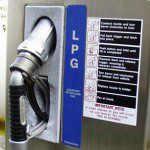
LPG (liquefied petroleum gas)
 LPG is a liquefied mixture of propane, butane and other additives, which is formed during the processing of petroleum feedstock. In the initial state, it has no color, taste and smell, therefore, an odor agent is added to the mixture - an odorant (a substance with a characteristic odor). LPG is non-toxic, but does not permeate air and has a moderate toxic effect. In the gaseous state, it is heavier than air, and in the liquid state, it is lighter than water. Therefore, LPG vehicles should not be left in underground garages, as in the event of a leak, LPG will always settle in the lowest places and displace breathable air.
LPG is a liquefied mixture of propane, butane and other additives, which is formed during the processing of petroleum feedstock. In the initial state, it has no color, taste and smell, therefore, an odor agent is added to the mixture - an odorant (a substance with a characteristic odor). LPG is non-toxic, but does not permeate air and has a moderate toxic effect. In the gaseous state, it is heavier than air, and in the liquid state, it is lighter than water. Therefore, LPG vehicles should not be left in underground garages, as in the event of a leak, LPG will always settle in the lowest places and displace breathable air.
LPG is produced during the processing of petroleum feedstocks. It is liquefied by cooling or pressing to reduce its volume 260 times. LPG is used as a cheaper alternative to gasoline as its properties are very similar. It is a fuel with very good properties, with an octane rating of around 101-111. In our conditions, the so-called winter LPG mixture (60% P and 40% B) and summer LPG mixture (40% P and 60% B), i.e. change in the mutual ratios of propane and butane.
| Propane | Butane | LPG Blend | Petrol | |
|---|---|---|---|---|
| Sample | C3 H8 | C4 H10 | ||
| Molecular weight | 44 | 58 | ||
| Specific weight | 0,51 kg / l | 0,58 kg / l | 0,55 kg / l | 0,74 kg / l |
| Octane number | 111 | 103 | 106 | 91-98 |
| Bod Varu | -43°C | -0,5°C | -30 to -5 ° C | 30-200 ° C |
| Energy value | 46 MJ / kg | 45 MJ / kg | 45 MJ / kg | 44 MJ / kg |
| Calorific value | 11070 kJ.kg-1 | 10920 kJ.kg-1 | 43545 kJ.kg-1 | |
| Flash point | 510 ° C | 490 ° C | 470 ° C | |
| Explosive limits in% by volume | 2,1-9,5 | 1,5-8,5 |
For a more precise expression (calorific value, calorific value, etc.), the "Theoretical Equivalence Coefficient" is defined for a volume of fuel containing a certain amount of energy equal to the calorific value of gasoline. Then the “actual ratio equivalence ratio” between the engine consumption is determined, which we can compare as best as possible.
| Fuel | Theoretical Equivalence Coefficient | Equivalence ratio |
|---|---|---|
| Petrol | 1,00 | 1,00 |
| Propane | 1,30 | 1,27 |
| Butane | 1,22 | 1,11 |
Let's take a car with an average gas mileage of about 7 liters. Then (taking into account the composition of the summer mixture and the equivalence coefficient, we obtain the formula:
(gasoline consumption * (40 percent propane with an equivalence of 1,27 + 60 percent butane with an equivalence of 1,11)) = LPG consumption
7 * (0,4 * 1,27 + 0,6 * 1,11) = 7 * 1,174 = 8,218 l / 100 km v lete
7 * (0,6 * 1,27 + 0,4 * 1,11) = 7 * 1,206 = 8,442 l / 100 km in winter
Thus, the difference in exactly the same climatic conditions will be 0,224/ 100 km. So far, these are all theoretical figures, but they explain the fact that consumption will grow only due to cooling. Of course, they are also responsible for a further increase in consumption - winter tires, winter starts, more lighting, snow on the road, maybe even less leg sensation, etc.
